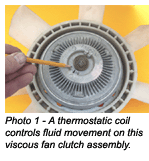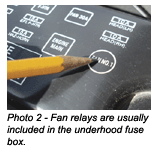Cooling fan operation is often taken for granted by many technicians because testing a cooling fan requires at least 15 minutes of fast idling or running until the coolant temperature reaches 220-230° F. If the cooling fan doesn’t activate, a coolant temperature sensor, fan relay, fan electrical circuit or the fan itself may be at fault. In other cases, the engine may overheat when driving in slow-moving traffic or when climbing steep mountain roads. In these cases, more dynamic issues such as inadequate airflow through the radiator or engine compartment might be the cause. In either case, it’s important to understand the basics of cooling system operation in order to determine the underlying cause of cooling fan failure.
Most modern liquid-cooled engines use a belt-driven water pump to circulate coolant through the lower cylinder area into the cylinder head, and from the cylinder head into the radiator. A few “reverse flow” engines are on the market in which coolant flows directly from the radiator to the cylinder head, which reduces cylinder head temperatures and better controls the rate of combustion in the cylinder head. In either configuration, a wax-pellet thermostat is used to prevent coolant circulation through the radiator until the engine assembly reaches a specified operating temperature of 170-195° F. Coolant temperatures in this range are the most conducive to maximum engine life, fuel economy and reduced exhaust emissions.
When the thermostat opens, coolant circulates through the radiator. When the coolant temperature exceeds a predetermined point in the radiator or engine cylinder block, a thermostatic switch activates the cooling fan, which then draws cool air through the radiator, circulates it around the engine assembly and exhausts it under the vehicle’s floor pan.
It’s basic physics, but heat always flows from hot to cold. The radiator acts as a medium between the hot coolant and the cool atmosphere. The cooling fan becomes the final part of the process by drawing cool air through the core tubes and fins of the radiator.
EFFECTS OF OVERHEATING
Because an aluminum cylinder head expands at a higher rate than the steel head bolts attaching it to the engine block, an overheated cylinder head tends to crush the cylinder head gasket during an overheating event. This crushing effect reduces head bolt tension during normal operating temperatures and increases the potential for future cylinder head gasket failure.
In addition, overheating expands pistons and piston rings well beyond their design parameters. Consequently, overheated pistons usually exhibit “four-point” scuff marks along the edges of the piston skirts where steel expansion control struts built into the piston have forced the piston skirt to contact the cylinder wall. Last, overheating causes the engine oil to rapidly oxidize and lose its lubricating qualities. Overheated engine oil also softens the alloy plating on crankshaft bearings, which results in the plating actually “wiping” or redistributing over the bearing surface under severe loads.
VISCOUS FAN DESIGNS
Belt-driven mechanical cooling fans have been standard equipment for most conventional engine installations. Unfortunately, cooling fans are needed only during low-speed driving when air circulation is at a minimum or during prolonged load conditions, when maximum engine cooling is needed. The remainder of the time, the constantly rotating mechanical cooling fan is not needed to cool the engine.
To improve fuel economy and reduce fan noise from mechanical fans, most imports use temperature-sensitive viscous-fluid drive clutches to engage the fan when needed. Viscous fan clutches are essentially composed of a closely spaced set of driving and driven friction plates. As the temperature of air flowing through the radiator core increases, the viscosity of the fluid increases, which, in turn, increases the friction between the driving and driven plates. In essence, the higher the radiator core temperature, the faster the fan rotates.
 With that said, keep in mind that numerous design variations of viscous fan clutches populate the market. The least sophisticated are those that contain the fewest parts and rely solely upon the friction created between the driving and driven plates to control fan speed. These designs are less costly and less efficient at controlling fan speed. The most sophisticated designs utilize a thermostatic spring mounted on the front of the fan clutch that controls the flow of viscous fluid to the driven plates. The more sophisticated designs are more sensitive to radiator core temperatures and are more efficient at controlling fan speeds. See Photo 1.
With that said, keep in mind that numerous design variations of viscous fan clutches populate the market. The least sophisticated are those that contain the fewest parts and rely solely upon the friction created between the driving and driven plates to control fan speed. These designs are less costly and less efficient at controlling fan speed. The most sophisticated designs utilize a thermostatic spring mounted on the front of the fan clutch that controls the flow of viscous fluid to the driven plates. The more sophisticated designs are more sensitive to radiator core temperatures and are more efficient at controlling fan speeds. See Photo 1.
In some chassis configurations, fan shrouds are used to help the fan draw air from the entire surface area of the radiator core. For optimum cooling, mechanical fans must generally be located about 1-2 inches inside the shroud, with generally no more than 1.5 inches of clearance between the tip of the fan blade and the shroud. Without adequate or correctly located shrouding, a mechanical fan develops a very inefficient airflow through the radiator.
VISCOUS CLUTCH DIAGNOSTICS
Viscous clutch fans can be difficult to diagnose because their engagement occurs very gradually over a very broad temperature range. In general, any serious leakage of viscous fluid around the input shaft or any wobble in the hub support bearings are enough to condemn a viscous fan clutch. In addition, most viscous clutches should resist rotation when rotated  by hand with the engine off. Moreover, when the engine is started, a good fan clutch will generally transition from engagement to disengagement as the viscous fluid migrates into an internal storage chamber.
by hand with the engine off. Moreover, when the engine is started, a good fan clutch will generally transition from engagement to disengagement as the viscous fluid migrates into an internal storage chamber.
ELECTRIC COOLING FAN DIAGNOSTICS
Early electric fans were activated by a temperature sensor installed in the engine block or radiator. When coolant temperatures reached 220° F and perhaps as high as 230° F, the fan sensor would activate an electric fan relay. See Photo 2.
Systems using radiator-mounted thermal switches rely very heavily on adequate coolant circulation through the radiator to activate the fan. If the thermostat fails to open completely or if the water pump impellor fails, radiator temperatures may not be sufficient to close the thermal switch.
As computerized engine management systems became more common, electric fan operations were integrated into the engine operating strategy. In these systems, the electric fan relay is grounded by a driver in the engine computer that responds to engine coolant temperature input. The engine computer may also respond to other inputs, such as high underhood temperatures when the vehicle is parked and during air conditioning or defroster requests. Electric fans may also be combined with engine-driven fans and may act as supplemental cooling when engine temperatures rise or when air conditioning or defrosting is requested.
Many electric fans are two-speed units, with the higher (and noisier) speed function engaging only when coolant temperatures might, for example, rise near 230° F or near the boil-over point of the cooling system.
BASIC FAN DIAGNOSTICS
Because most modern electric cooling fan applications are managed by the PCM or engine computer, the bidirectional feature of many scan tools can be used to verify fan, fan circuit and fan relay functions. The scan tool data stream may also be used to verify the temperature at which the fan activates.
When bidirectional controls aren’t available, use vehicle-specific service information to diagnose electric cooling fans. Some early applications, for example, might use a fan control module to operate the fan while others might use a more conventional thermal or computer-controlled switch to activate the fan.
When replacing fan motors, it’s important to ensure that the fan motor meets OE specifications for both amperage and two-speed functions. To illustrate, the amperage rating of a fan motor indicates its power to move air. Substituting a lower-amperage motor will decrease the ability of the fan to move air. Although the high-speed function isn’t used in normal driving, the lack of high-speed operation may cause severe overheating in high-demand situations.
Keep in mind also that, during initial start-up, an electric motor draws a much higher-than-normal amperage. Consequently, a general rule of thumb is a fuse capacity that is at least 1.5 times the fan’s normal amperage rating. A higher-than-specification fuse should never be substituted to compensate for a defective fan motor. Doing so may overheat the fan relay and damage related wiring.
AIRFLOW DIAGNOSTICS
After replacing a defective fan, verify airflow through the grille, air conditioning condenser and radiator. A spare tire mounted on the front bumper of a recreational vehicle or a radiator or A/C condenser clogged by road debris drastically reduces the ability of the fan to cool the radiator. Last, OE chin spoilers and other aerodynamic devices help the fan evacuate hot air from under the vehicle itself. Always make sure that the original equipment air foils and ducting are in place before condemning any cooling fan as a cause of overheating.












